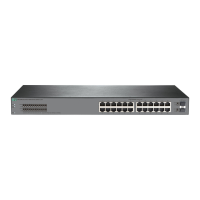32
Both the storm-constrain command and the unicast-suppression command can
suppress unknown unicast storms on a port. The
unicast-suppression command uses the
chip to physically suppress unknown unicast traffic. It has less influence on the device performance
than the
storm-constrain command, which uses software to suppress unknown unicast traffic.
For the unknown unicast traffic suppression result to be determined, do not configure both the
storm-constrain unicast command and the unicast-suppression command on an
interface.
When you configure the suppression threshold in kbps, the actual suppression threshold might be
different from the configured one as follows:
• If the configured value is smaller than 64, the value of 64 takes effect.
• If the configured value is greater than 64 but not an integer multiple of 64, the integer multiple of
64 that is greater than and closest to the configured value takes effect.
To determine the suppression threshold that takes effect, see the prompts on the switch.
Examples
# Set the unknown unicast storm suppression threshold to 10000 kbps on GigabitEthernet 1/0/1.
<Sysname> system-view
[Sysname] interface gigabitethernet 1/0/1
[Sysname-GigabitEthernet1/0/1] unicast-suppression kbps 10000
The actual value is 10048 on port GigabitEthernet1/0/1 currently.
The output shows that the value that takes effect is 10048 kbps (157 times of 64), because the chip
only supports step 64.
Related commands
broadcast-suppression
multicast-suppression
Layer 2 Ethernet interface commands
display storm-constrain
Use display storm-constrain to display storm control settings and statistics.
Syntax
display storm-constrain [ broadcast | multicast | unicast ] [ interface
interface-type interface-number ]
Views
Any view
Predefined user roles
network-admin
network-operator
Parameters
broadcast: Displays broadcast storm control settings and statistics.
multicast: Displays multicast storm control settings and statistics.
unicast
: Displays unknown unicast storm control settings and statistics.

